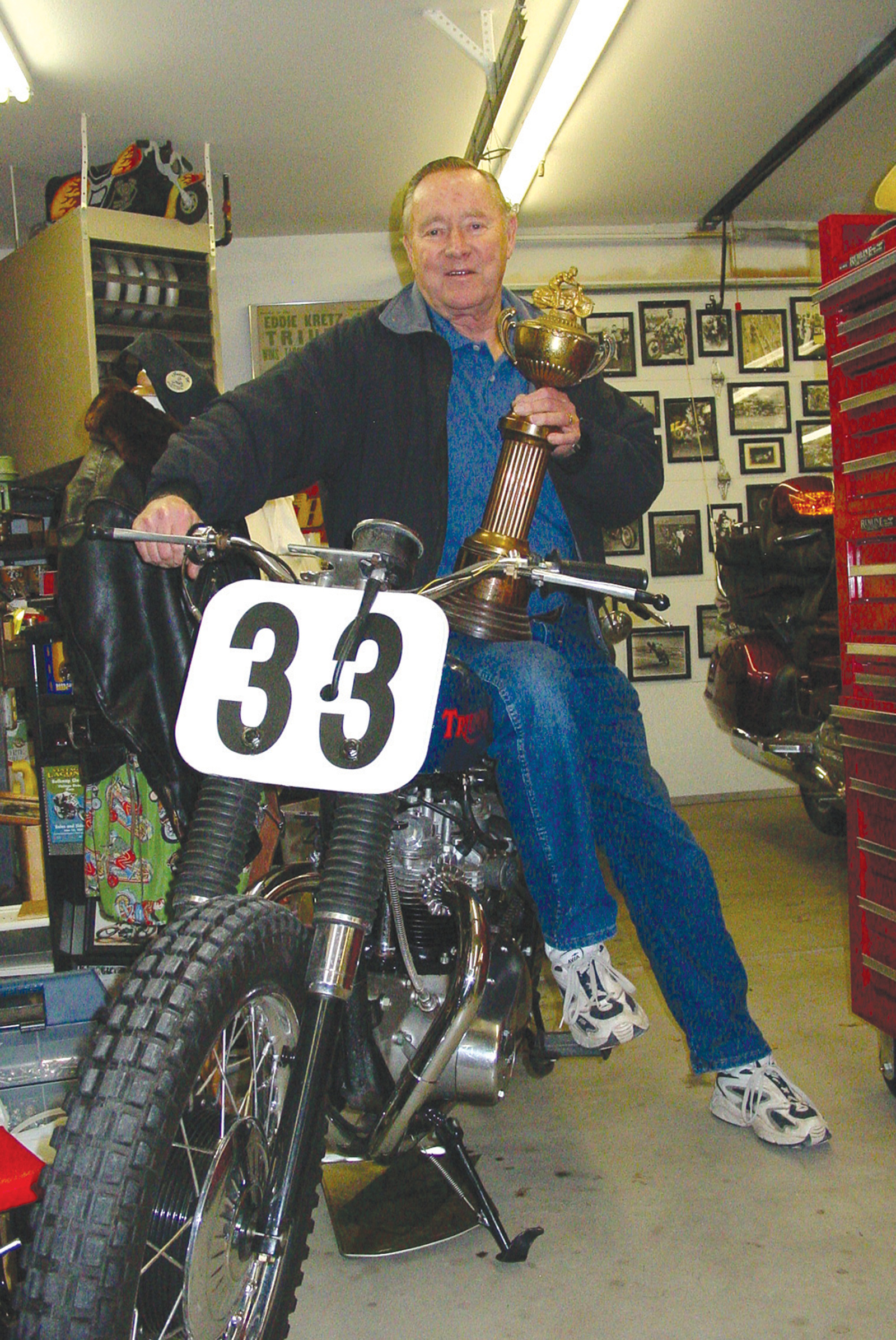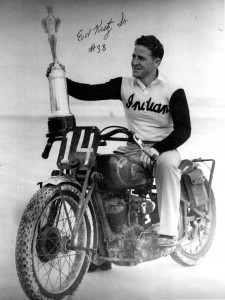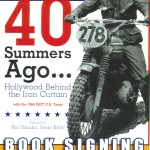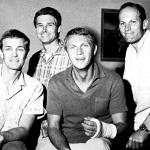By S. Clayton Moore
You wouldn’t know it to look at him, but Ed Kretz Jr. is one of the world’s greatest motorcyclists. Sitting in the kitchen of his home in the Colorado hills, Kretz is a quiet, gentle soul, a little sunburned and with some age in his eyes. The few faint scars from his racing days don’t reveal the story of his remarkable days as a motorcycle racer.
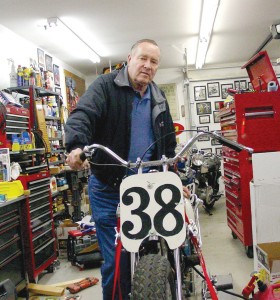
Ed Kretz Jr. shows off his private museum, starting with his father’s famous Indian Scout that won the 1937 Daytona 200.
During the pinnacle of his career in the late 1950s and early 1960s, he raced alongside some of the world’s most famous racers, pushing Indians and Triumphs to the very edge of their capabilities. His racing buddies included screen legends like Steve McQueen and Lee Marvin, television stars like Jay Leno, and world-famous racers like the “Indian Wrecking Crew” of Bobby Hill and Bill Tuman.
Perhaps no one in Kretz’ orbit was more famous than his father, Ed Kretz Sr., who won the very first Daytona road race in 1937. Known as the “Iron Man” for his amazing endurance on a bike, the elder Kretz was the greatest motorcycle racer of his time and one of the sport’s first major stars.
Ed Kretz Jr. now lives in Sedalia, Colo., with his lovely wife, Elaine, once a trophy girl for some of his races. He still keeps a small collection of the famous motorcycles on which he and his father rode to glory. A small outbuilding outside his modest home houses an amazing collection of bikes, trophies, photographs, jackets and other memorabilia that recall nearly a century of American racing history.
At 73, Kretz still has a fire in his eyes when he talks about just how much fun it was to race.
Kretz and son
You can’t talk about the son without first introducing his father. Ed Kretz was born in 1911 in San Diego, and started riding motorcycles out of sheer necessity during the Depression. Another legendary racer, Floyd Clymer, saw his talent and managed to get the young rider to race a new Indian motorcycle.
As he progressed through the racing circuit, Kretz quickly became one of the best-known racers in the country. He stood at only 5’8″, but weighed a muscular 185 pounds, and used his sheer physical strength in a style no one had ever seen before.
“My dad was strong like a bull,” his son remembered. “He drove a hay truck and would load and unload the bales by himself. He was shorter than I was, but he was stocky.”
That strength served the elder Kretz well during his most famous race, the inaugural Daytona 200 in 1937. The race was already well-known in its first year and went on to become the single most important motorcycle race in America.
The races were held on the beach until 1961, with riders changing back and forth between Daytona Beach and Highway A1A over a 4.1-mile course. With no fences and just a few simple rules, some truly gutsy racers chased each other at speeds approaching 100 mph. Kretz won the first Daytona 200 on Jan. 24, 1937, with an average speed of 73 mph.
“He was nicknamed ‘Iron Man’ because he would be running just as fast at the end of a 200-mile race as he was at the beginning,” Kretz said. “That bike probably wouldn’t run 100 mph, but he was very good and he was determined to win. If the engine didn’t blow up or he didn’t fall off, he would usually win the race.”
It wasn’t enough for Ed Kretz just to go fast. There had to be someone else to race against to make the difference.
“Going out to time trials by himself, sometimes he would be the last one to qualify because he didn’t have anyone to race against,” his son observed. “Once the race started he was way in the back, but by the second lap, he’d be leading the pack.”
Outside of their racing careers, Kretz and his son sold motorcycles for a living. Kretz had worked for Floyd Clymer’s dealerships during the 1940s and started his own business selling Indians in 1944. The business prospered for more than 40 years until his son sold the dealership in 1985.
“It started in a garage, originally,” Kretz Jr. remembered. “He was just buying up used bikes, fixing them and selling them. He made enough money that way so he could go racing.”
Guys at the races
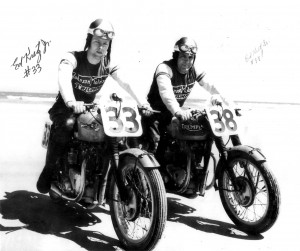
Among the amazing photographs at Ed Kretz’ home is a signed photograph of father and son at the races.
Born in 1932, Ed Kretz Jr. started working at his father’s dealership when he was just in grammar school.
“I would go down after school and clean the floors and wash bikes,” he remembered. “I only ever had one job, and that was working for my dad.”
Working at the dealership wasn’t always easy. Ed Kretz Jr. got in big trouble with his father when he was caught skipping classes to come down to the store.
“During PE, instead of running around, I would take off and go wash bikes,” he laughed. “My report card had an F in PE. My dad gave me hell for not knowing how to play right.”
It was an amazing place to grow up and Kretz had access to the world’s most famous racers. One was Burt Munro, who came into the shop to tinker with his motorcycle and later broke the land-speed world record in 1967. His story hit the big screen in February in “The World’s Fastest Indian,” starring Anthony Hopkins.
Even more famous racers were hanging around.
“Another one I knew was James Dean,” Kretz remembered. “Jimmy liked motorcycles, and he and my dad were pretty close. My dad was friendly with him because they were both racing these little sports cars and they did some car racing together back in the 1950s. A lot of those guys who were into motorcycles also raced cars, because it helped in judging distances.”
Dean was driving his Porsche 550 Spyder to Monterey, Calif., for a race when he was killed on Sept. 30, 1955.
“We were going to the races that day when we heard about it,” Kretz said. “He was killed so young. He was a very quiet guy. Back then, they were just these guys at the races.”
“Racing is racing”
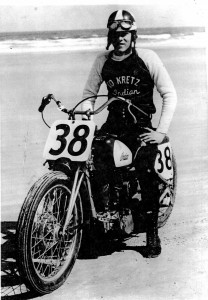
Ed Kretz Jr. nearly won the amateur event at the 1950 Daytona 200, before the engine seized in the last half-mile.
Ed Kretz Jr. started riding when he was just a child.
“I grew up with my dad, and I always went with him to the races,” Kretz said. “I was riding his big old Indian when I was just 10 years old. I had to pull up to the curb to get off the bike because my feet couldn’t touch the ground.”
Kretz was 16 when his father asked him, “Well, do you want to try a race?” He began racing in 1948, using the same Indian “45” Scout his father used to win Daytona in 1937. In tribute, he also proudly wore his father’s number, 38, during the first years of his career. He quickly developed into a leading amateur contender, nearly winning the 1950 amateur event at Daytona.
“I led the race all the way up to the last mile,” Kretz said of the 100-mile race. “You raced up the beach two miles and then made this racetrack turn and came up the backstretch on the pavement. I could see the finish flags just down the road when the engine seized and blew all the oil out. I hit the clutch and coasted with everyone just flying by me at about 50 miles an hour.”
Half a block from the finish line, Kretz was determined to at least finish the race. He ultimately came in twelfth.
“I felt like I was stopped so I tried to get off,” he remembered. “It turned out that I was actually going about 20 miles an hour, so my feet flew out from under me. Somehow I hung onto the handlebars and managed to get across the line.”
Later that year, Kretz won the amateur race of the Laconia Classic in New Hampshire. Also in 1950, he took second at the Springfield (Illinois) Mile. By 1951, he was a rookie expert, earning enough points to become national #33.
It wasn’t always easy being the son of Ed Kretz.
“There were a few times when it was a little rough,” Kretz said. “I had an incident at a national race in California. When I went to the payoff window, I found that I had won second place instead of third, and I was awarded a couple of hundred dollars more. This other rider yelled and screamed that Kretz had pulled some strings. I just told him, ‘Hey, racing is racing.'”
Kretz was coached through his racing career with a good mix of encouragement and tolerance from his father.
“He was a pretty good coach,” Kretz said. “He never pressured me into racing. He always said that if I wanted to do it, he’d help me get started. I mostly just did it and learned from experience.”
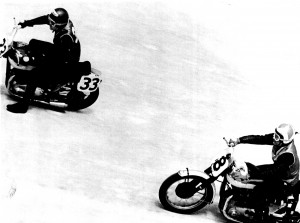
Ed Kretz Jr., on a Harley-Davidson (left) and Ed Kretz, on his Triumph, race during the 1956 Daytona 200. “That was the one time I beat him, just barely,” said Kretz Jr.
He missed a few racing seasons while serving in the U.S. Army overseas. He was stationed for two years in Germany, where he was assigned to the motor pool to work on tanks and jeeps. He still got to ride, through some strings his dad really did pull, with the Triumph motorcycle factory.
“My dad made arrangements to send me a bike in a crate,” Kretz laughed. “I actually put it together with the little tools that came in the crate. I guess they thought I was going to race it.”
Kretz came back to racing in 1955 and was better than ever. He began specializing in TT racing, an exotic sport that resembles today’s motocross racing, with roots in the English countryside.
“TT racing stands for Tourist Trophy,” Kretz explained. “It differs from a flat track in that it has all these left-hand and right-hand turns as well as jumps. I enjoyed it more because it’s a lot more challenging than just driving around in a circle. My dad and I both enjoyed that style of racing because it’s tougher than flat track racing.”
Kretz scored his sole national victory in the Peoria TT in September 1955, taking the lead around the fifth lap and eventually beating future AMA Grand National Champion Brad Andres. He managed to nail a pair of top-five finishes at Peoria in 1956, and tied for sixth in the AMA Grand National Championship standings. He also won the 200cc class at the Catalina Grand Prix and was the Northwest Motorcycle TT champion.
Despite his extraordinary professional achievements, Daytona was one race that Kretz just couldn’t win.
“I never did do any good at Daytona,” Kretz said. “The engines would go out. The clutch would go out. I always seemed to have problems. I always enjoyed it and had fun going, but I had to win other races just to get the money to come home.”
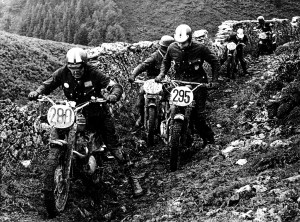
John Steen and Ed Kretz Jr. (right) try to negotiate the muddy trail at the 1965 International Six-Day Trials on the Isle of Man.
In 1955, he was doing well when he had a difficult crash.
“I was doing well that year, running third,” he recalled. “I was all tucked in, running about 100 miles an hour and moved out to miss another competitor. I wasn’t paying attention and I hit the incoming wave. I went head over heels, like I was on water skis.”
The following year, the motor went out again, but Kretz managed to make his best finish anyway, with a little help from his father.
“I’m kicking and screaming, but the engine was just full of water and wouldn’t start,” Kretz remembered. “My dad came around and the clutch was going out on his bike, so he came over, put his foot on the back of my bike while he was running about 90 miles an hour and gave it a kick. It blew all that stuff out of there and it took off, running better than it had. I ended up finishing twelfth, which is about the best I ever did.”
By the early 1960s, Kretz was starting to slow down his racing but he wasn’t ready to quit yet.
Kings of cool
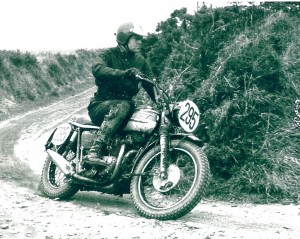
Ed Kretz Jr. raced screen legend Steve McQueen’s Triumph motorcycle at the 1965 International Six-Day Trials in England.
When not racing on the national circuit, Kretz did a lot of road racing events on the West Coast, riding a number of different bikes.
“The Indian was pretty close to my heart, but in 1953, they went out of business,” Kretz explained. “Dad took on Triumphs in 1949, but they didn’t get popular until the 1950s. They were easier to ride, handled better and they had more horsepower. You could do a lot more to make them run faster.”
He was also one of the first riders in America to race the Honda 250cc. He even wrote up a review of the new Japanese bike for Cycle World magazine.
“That was an amazing bike,” he recalled. “For being a 250cc machine, it would run 150 miles per hour. It had a seven-speed gearbox and it sounded like a bumblebee, but it was a nice motorcycle.”
Kretz married his high school sweetheart, Elaine, a trophy girl at many of the events where he raced, after high school in 1953. Their daughter, Cindy, was born as the new decade began. By 1962, he decided to retire from the national circuit.
He kept up road racing on the West Coast. That’s where he started running with screen actor Steve McQueen and McQueen’s hell-raising buddy, Bud Ekins, who later went on to fame as the stuntman who made the infamous motorcycle jump in “The Great Escape.”
“Steve was a good friend,” Kretz said. “He would come out and ride a lot of the desert rides when we were there, as would Bud Ekins and Lee Marvin, who was also a pretty good motorcycle rider. You’d get out in the desert and do your thing and have fun. That’s how I got to know him.”
McQueen’s passion for racing is infamous and widely known through his screen work in films like “The Great Escape,” “Bullitt,” “Le Mans” and the lesser known but influential motorcycle film “On Any Sunday.” In 1964, the actor landed a spot on the American team for the International Six-Day Trials, a strenuous off-road race held that year in Erfurt, East Germany.
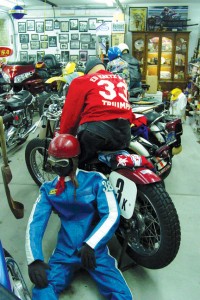
Ed Kretz Jr.’s small private museum includes motorcycles, photographs, trophies and original racing leathers.
The following year, McQueen was committed to filming “The Cincinnati Kid” and wasn’t available to run the 1965 ISDT being held on the Isle of Man in England.
“He rode this factory Triumph in Germany in 1964,” Kretz explained. “He was going to ride it at the Isle of Man, but he just couldn’t get out of the movie. He wanted to know if I wanted to ride it because, after all, it was there. I said, ‘Sure, I’ll ride it.'”
Unfortunately for Kretz, the International Six-Day Trial turned into about three days of mud. The weather turned so bad that none of the Americans finished the race.
“We raced on a walking trail. Just the day before, you could walk it with no problem,” Kretz remembered. “The second day, it just rained and rained. Underneath this shale was slate rock so you couldn’t get any traction at all. You literally had to push your bike through it. I had a crash that bent up the front fork of the bike so badly that it was just a goner.”
The races have been chronicled in a new book, “40 Summers Ago: Hollywood Behind the Iron Curtain.” The book focuses on Steve McQueen but includes contributions from other riders such as Ed Kretz Jr., Bud and Dave Ekins, and Cliff Coleman.
The connection to McQueen continued until the end of the star’s life. When McQueen was dying of cancer in 1980, the elder Kretz drove him to Mexico for treatment.
Ed Kretz Jr. took a few of his own bumps and bruises, which helped lead him into retirement from motorcycle racing.
“I had a few good friends who were killed, and I got hurt a few times,” he said. “I lost a lot of skin and hide. I broke a collarbone once. A guy got into a wobble and drove me over the fence. I hit the chain-link fence, which saved me, but my body looked like a black-and-blue checkerboard.”
Racing ambassador
Kretz worked for his father, building up their motorcycle dealership in Monterey Park, Calif., until the two famous motorcyclists decided to fully retire in 1986.
“One of the reasons we got along in business so well was that I didn’t ever argue with him,” Kretz remembered. “He was a tough guy.”
He remembered one of his father’s birthday parties, attended by motorcycle enthusiast and “Tonight Show” host Jay Leno. Guests asked for Leno’s autograph but the television star wouldn’t budge until Ed Kretz signed his T-shirt.
Ed Kretz Sr. passed away on Jan. 30, 1996, nearly 60 years after he won Daytona’s first victory. He’s buried in Whittier, Calif., under a handsome headstone with a carving that reads “Iron Man.”
In 1995, Ed and Elaine Kretz moved to Colorado to be closer to their daughter, Cindy, and their four grandchildren. They see Cindy every week while volunteering at University Hospital, where she manages services for the hospital’s cancer ward.
Kretz has also kept the most important pieces of memorabilia from both his father’s racing career and his own. In the small outbuilding behind his home are several Indians, a few Triumphs and a half-dozen other motorcycles that Kretz tinkers with from time to time. Perhaps the most valuable is the original Indian “45” Scout used by Ed Kretz when he won Daytona. It’s still emblazoned with #38.
Kretz was inducted into the National Motorcycle Hall of Fame in 2002. He practically has his own hall of fame in the small garage. The trophy from the 1937 Daytona 200 is on a shelf, as is the younger Kretz’ trophy for winning Peoria in 1955. Included in the collection are hundreds of pictures, many signed by the elder Kretz himself and many of motorcyclists from 50 years of racing history.
The “museum” is private but Kretz does occasionally open it up for visitors.
“People do come see it,” he said. “I don’t publicize it, but friends come to visit and several motorcycle clubs have come by on their rides.”
Kretz has also been an ambassador for the sport he loves, serving as grand marshal for vintage races, including the Belknap Classic and Vintage Laconia Races in New Hampshire and the Pikes Peak Hill Climb in Colorado Springs, Colo.
Through it all, Kretz has kept his love of motorcycle racing.
“It was always a thrill to get out there,” he said. “I was a little anxious before the races, but then the flag would drop and I’d be cool.”
More information about Ed Kretz and Ed Kretz Jr. is available at the National Motorcycle Hall of Fame’s website at [http://www.motorcyclemuseum.org]. For more information about the International Six-Day Trials, visit [http://johnsonmotorsinc.com/news/40yearfr.htm].
- Ed Kretz shared a love of motorcycles and sports cars with many hot-rodders, including an up-and-coming actor named James Dean, pictured here with the Porsche Spyder he was racing at the time of his death.
- The exploits of Steve McQueen, Bud Ekins and Ed Kretz Jr. at the International Six-Day Trials were recently written about in the new book “40 Summers Ago: Hollywood Behind the Iron Curtain.”
- Among Ed Kretz Jr.’s racing buddies was the King of Cool, Steve McQueen, pictured here in his pivotal role in “The Great Escape.”
- The 1964 American team for the International Six-Day Trials is pictured a few days before the race began, L to R: Dave Ekins, Bud Ekins, Steve McQueen and Cliff Coleman.
- Both Ed Kretz and his son stayed friends with fellow racers Bud Ekins (left) and Steve McQueen.











